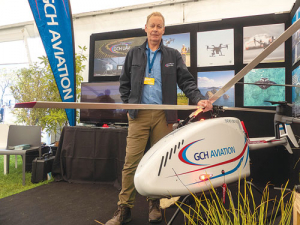Wairarapa’s Bradley Wadsworth blends farming and technology
Bradley Wadsworth lives on the family farm – Omega Station – in the Wairarapa about 30 minutes’ drive east from Masterton.
 GCH Aviation’s Drone Operations manager Rob Duff with the large gas turbine drone the company is trialling for a range of applications including agriculture. Photo: Rural News Group
GCH Aviation’s Drone Operations manager Rob Duff with the large gas turbine drone the company is trialling for a range of applications including agriculture. Photo: Rural News Group
The world may be going all-out on electric vehicles, but GCH Aviation, Christchurch, is trialling a large, gas turbine-powered drone to service farming clients.
GCH (formerly Garden City Helicopters) was showing off a Swiss-made SD50 at last year’s New Zealand Agricultural Show, carrying a $500,000 price tag.
It has two contra-rotating intermeshing rotors so no tail rotor is required. It can fly for 2.5 hours and carry a payload of 40kg. That endurance is a game-changer, claims Darryl Hodgson, general manager of GCH’s UAV (unmanned aerial vehicle) division.
“At the moment, it doesn’t matter what [drone] you’ve got, they’ve all only got a battery life of about 20-30 minutes.”
And the battery life will be even less in a drone that must power, say, a big multi-spectral camera or high-end LIDAR unit. However, uniquely, the SD50 carries its own generator.
GCH Aviation has bases NZ-wide and experience in helicopter and fixed wing services.
It entered the UAV sector in Marlborough about two years ago and now flys electric drones to map farms and vineyards to monitor for pests, diseases and growing stresses such as moisture and nitrogen deficiencies.
At first it met resistance from farmers who had been burned by “backyard guys” who flew off-the-shelf drones and sold the farmers nothing more than “pretty pictures”. Now it can provide collected data and proper analysis of that data.
GCH contracts this part of the service to an experienced US partner company which delivers a report to the farmer in the preferred format. An example is delivering instructions for a GPS-enabled, variable-rate fertiliser or spray application.
The SD 50 can also be configured with a spray boom for use on high-value crops or weed control in areas of poor access, typically where a full-size manned helicopter would not be economically viable.
Hodgson says that while the concept is not new, having a seamless package was preferable to dealing with several providers.
He says the SD50 gas-turbine power unit opens the door to survey a farm of 200ha in one go and at very high accuracy.
A Taranaki farmer and livestock agent who illegally swapped NAIT tags from cows infected with a bovine disease in an attempt to sell the cows has been fined $15,000.
Bill and Michelle Burgess had an eye-opening realisation when they produced the same with fewer cows.
It was love that first led Leah Prankerd to dairying. Decades later, it's her passion for the industry keeping her there, supporting, and inspiring farmers across the region.
Rangitikei Rivers Catchment Collective (RRCC) chairperson Roger Dalrymple says farmers in his region are taking a national lead in water quality awareness and monitoring.
One young couple is proving farm ownership is still within reach for young Kiwis.
Greenlea Premier Meats managing director Anthony (Tony) Egan says receiving the officer of the New Zealand Order of Merit (ONZM) honour has been humbling.

OPINION: The release of the Natural Environment Bill and Planning Bill to replace the Resource Management Act is a red-letter day…
OPINION: Federated Farmers has launched a new campaign, swapping ‘The Twelve Days of Christmas’ for ‘The Twelve Pests of Christmas’ to…